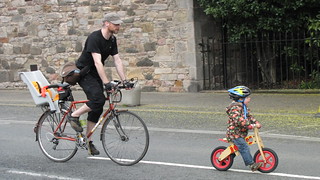The Volvo Enviro400XLB used by Lothian Buses weighs about 11,000kg empty, spread over 3 axles. It can carry 100 people, each of whom weighs the European industry standard 70.8kg.
The axle load when empty is about 3,667kg, and when full, 6,050kg - or rather, increases by 23kg per person onboard. A bus with one passenger plus the driver would have an axle load of 3,714kg.
A Kia Sportage with the nice drivedrain weighs 1,600kg, spread over 2 axles. It can carry 4, maybe 5 people. So its axle load when empty is 800kg, and when full of 4 people, 942kg. Although we need at least 25 cars to match the bus, the load isn't increased per axle: it's distributed proportionately along the road, although I suppose it would be cumulative as one car after another passes the measurement point. 100 driver-only cars would each have an axle load of 835kg.
So, 25 full cars would weigh 47,080kg across 50 axles (that is, 942kg per axle) and 100 driver-only cars would weigh 167,080kg across 200 axles (that is, 835kg per axle again).
The road stress is the ratio of one axle load to another, raised to the fourth power. With the driver and a hundred passengers in the bus, and just the driver in each car, the ratio is 6050 to 835, or 7.25:1. Thus the full bus causes 2755 times the stress to the road surface as one car, which is a) terrible, and b) fairly self-evident. But we need 100 cars to carry that many passengers (whom we assume can all drive and all have access to a car!). To put it another way, one car would have to be driven repeatedly the best part of three thousand times over the same bit of road to put the same stress through the surface. Or, each of the 100 cars would have to drive 28 times over the same piece of road.
Fully loaded, the ratio is 6050 to 942, or 1701:1 - still pretty poor for the bus, if we ignore the road space needed by all those cars, and if the road surface was perfectly elastic and in perfect condition. The 25 cars would each have to be driven 68 times over the same piece of road to put the same cumulative stress into the tarmac.
We could theoretically smoosh all the cars into the same space so that two axles carried the whole weight.
25 cars would be 25 x (1600 + 4 x 70.8) = 47,080kg, or 23,540kg per axle. In this instance, we have bus:car ratio as 6050 to 23540, or 1:3.89, thus 229 times the road stress from 25 cars compared with one bus.
100 cars would be 100 x (1600 + 1 x 70.8) = 167,080kg, or 83,540kg per axle. Then we have 6050 to 83540, or 1:13.8, thus 36,354 times as much road stress compared with one big bus.
I think.
The bottom line is as common sense might suppose:
- running empty buses is bad for the road and bad for revenue;
- running full buses is better for revenue, but they are still bad for the road unless it's built to a heavier grade;
- small axle loads damage the surface; high axle loads damage both the surface and subgrade; cumulative surface damage damages the subgrade once surface defects are established;
- acceleration and braking at bus stops is probably the main source of road damage, exacerbated by heavier, more powerful buses with more torque at the wheels*;
- steel wheels on steel rails are still better for shifting a lot of people from one place to another quickly;
- steel wheels carrying very heavy loads on steel rails require more axles, and more robust infra (heavier rails and deeper ballast);
- if you have to drive, fill it with other people and car share;
- get cars off the road anyway for both the cumulative stress to tarmac they cause, and for the congestion they cause.
* The torque of an electric motor isn't really why trolley buses often had two rear driving axles, it was so that they could be made longer than the original regulation 28 feet for two axles, and thus carry more people.

 posts
posts
